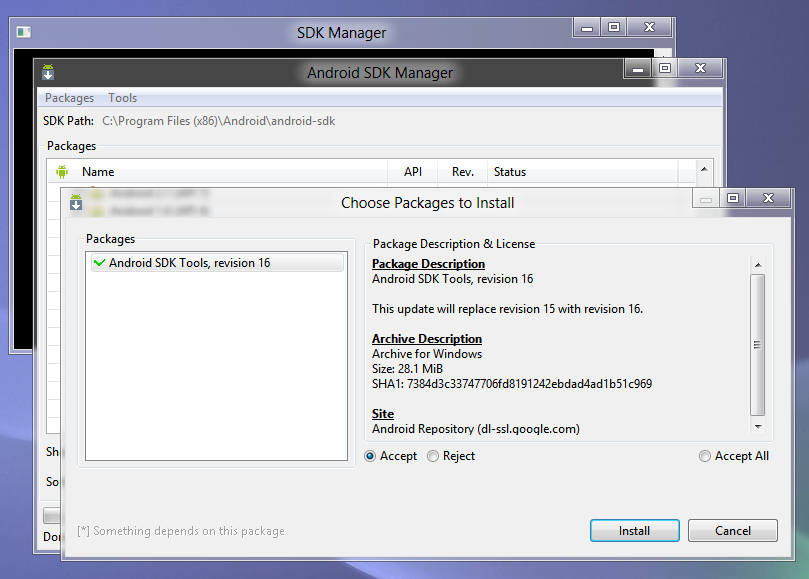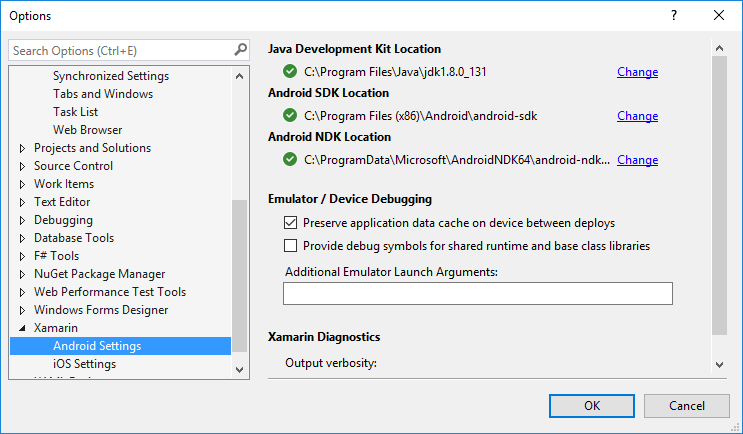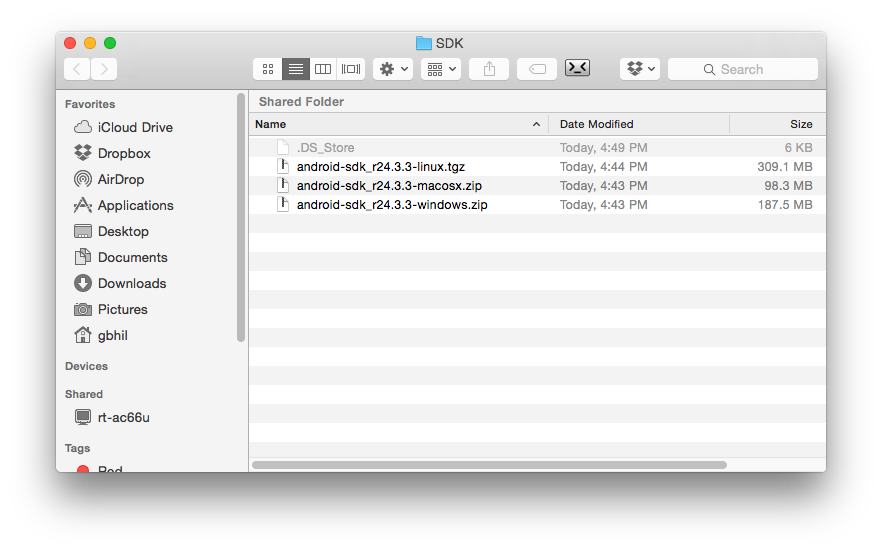Android Sdk Install For Mac
- How to install ANDROIDSDKROOT on Mac OS? Ask Question Asked 8 months ago. Active 8 months ago. Viewed 1k times 0. I can not understand how to install ANDROIDSDKROOT variable for the Mac OS. Search on stackoverflow already made, the code on recommendations tried to use.
- In the following screenshot, the Android SDK under Program Files (x86)Android is being selected: When you click OK, the SDK Manager will manage the Android SDK that is installed at the selected location. The Tools tab displays a list of tools and extras. Use this tab to install the Android SDK tools, platform tools, and build tools.
Updates:
Terms and Conditions This is the Android Software Development Kit License Agreement 1. Introduction 1.1 The Android Software Development Kit (referred to in the License Agreement as the 'SDK' and specifically including the Android system files, packaged APIs, and Google APIs add-ons) is licensed to you subject to the terms of the License Agreement.
- 2016-08-13: Added Gradle and VS Code. Changed from JDK7 to JDK8. Removed Ant.
If you are like me and just starting to work with the Ionic Framework and don’t already have a machine setup to do Android, iOS, Node, etc development then many of the guides out there leave out a number of steps that you need to do in order to get everything working.
Even being a Windows user I was able to pretty easily get Ionic working on a Mac. The only difference between the Windows setup and the OSx setup is that you can build for an iOS device on a Mac.
Software to be installed
- Global Npm Modules:
- Genymotion (Android emulator replacement) `- XCode
- XCode Command Line Tools
Android Sdk Download Linux
General Install Steps
Google Chrome
We need Google Chrome in order to debug our application when it is running on a device. The device emulation and developer tools are also extremely useful to have.
Download from https://www.google.com/chrome/browser/desktop/
Node
- Install the LTS version of node from https://www.nodejs.org
Npm Packages
Open a terminal and run the following commands to install the Global NPM packages that we need:
At this point, we can create ionic projects and test them in a web browser. To make sure that functionality is working:
Verifying General Install
In your open terminal, navigate to the directory where you store your development projects (I use ~/projects)
From ~/projects run:
ionic start todo blank
cd into todo (directory was created by the ionic start command)
Run the following command to run the todo app we generated in a web browser
ionic serve –lab
In the next section, we will install everything needed to deploy to an Android device.
Android Setup Steps
In order to deploy to an Android device you need to install the Java JDK, Android Studio, and Android SDK. We will walk through installing all of the required software setup.
JDK 8
Download from http://www.oracle.com/technetwork/java/javase/downloads/jdk8-downloads-2133151.html
After the install, launch a terminal and create a ~/.bash_profile if it doesn’t already exist. You can use touch ~/.bash_profile to create the file.
- Open up either vi or nano and add the following line:
export JAVA_HOME=/Library/Java/JavaVirtualMachines/jdk1.7.0_72.jdk/Contents/Home
Android Studio
Download from http://developer.android.com/sdk/index.html#Other
Android SDK
Download the Android SDK from [http://developer.android.com/sdk/index.html#Other](http://developer.android.com/sdk/index.html#Other_
Unzip the downloaded SDK to to ~/Development
Open ~/.bash_profile and add the following line:
In the terminal type source ~/.bash_profile to load the ~/.bash_profile changes.
Now we need to download the Android APIs versions that we care about. In this case, we are only going to install the API 23 Android SDK Tools and Android SDK Build-Tools
In the terminal window, type android to launch the Android SDK Manager.
Install the the following
- Tools -> Android SDK Tools
- Tools -> Android SDK Build-Tools
- Tools -> Android Platform-Tools
- API 23 -> SDK Platform
Genymotion Setup
Download Genymotion from https://www.genymotion.com/.
The Genymotion installer will also install VirtualBox if it is not already installed.
Once Genymotion is installed, we need to download a device.
- Open up the Genymotion UI and click on the Add Button.
- Then click the Sign in button and follow the login instructions to login with the account that you create as part of the Genymotion download.
- After you are logged in, select from the Android Version drop down 4.4.4
- From the Device model drop down select a device type
- Then select a device from the available list
- Click the Next button.
- Click the Next button and wait for the device to download
- Click the Finish button.
Verify the Android Setup
Open terminal
Navigate to the todo app that we create as part of the general install verification. (I used ~/projects/todo)
If you need to ceate the todo app run the following from ~/projects:
ionic start todo blank
cd into todo (directory was created by the ionic start command)
The todo app is now setup to be able to deploy to an Android device. To validate that we can build for Android, run the following:
The todo app is now setup to be able to deploy to an Android device. To validate that we can build for Android, run the following:
The last thing we need to verify is that we can deploy the todo app to the Genymotion Emulator. Before we can deploy the application, we need to start up the emulator.
Start the Genymotion device you downloaded and run:
ionic run android
You are now ready to go create ionic applications that you deploy to an Android device.
iOS Setup Steps
XCode Setup
Install Xcode from app store. This will take awhile since it is ~2 gigs in size.
- Once install is completed, open xcode and accept the license
Install the iOS Simulator that Ionic will use.
npm install -g iOS-sim
Note that if you just install NodeJs without using HomeBrew, you may have to add sudo in front of the npm install commands.
Verify the iOS Setup
Open terminal
Navigate the directory where you store you development projects (I use ~/projects)
If you need to generate the todo app, run the following command from the ~/projects directory
ionic start todo tabs
cd into todo (directory was created by the ionic start command)
We need to do is tell ionic that we want to add the iOS platform to our todo app by running:
The todo app is now setup to be able to deploy to an iOS device. To validate that we can build for iOS, run the following:
The last thing we need to verify is that we can deploy the todo app to the iOS Simulator by running:
ionic run iOS
You are now ready to go create your ionic applications.
Share Post:
Please enable JavaScript to view the comments powered by Disqus.comments powered by DisqusTake note (and take photo) on the installation locations of “Android Studio” (by default @ ” C:Program FilesAndroidAndroid Studio “) and the “Android SDK” (by default @ c:UsersusernameAppDataLocalAndroidSdk ).
Does Android Studio install SDK?
You can install Android SDK platform packages and tools from Android Studio. To open SDK Manager, do any of the these: On Android Studio landing page, select Configure > SDK Manager. From your Android Studio application toolbar, click SDK Manager.
Where Is Android Sdk Installed
Where is the Android SDK folder?
SDK folder by defalut is in C:Users<user-name>AppDataLocalAndroid . And the AppData folder is hidden in windows. Enable show hidden files in folder option, and give a look inside that.

Where is Android SDK installed Linux?
Install Android Studio in Ubuntu. Set the JAVA_HOME environment variable to the location of your JDK installation. Download the Android Studio package for Linux and extract it somewhere (e.g home directory). To launch Android Studio, open a terminal, navigate to the android-studio/bin/ directory, and execute studio.sh
Where is Android SDK installed Mac?
The location of the folder is located in the text box near the top that says “Android SDK Location”. By default the Android SDK location is stored at “/Users/[USER]/Library/Android/sdk” or at “/Library/Android/sdk/”.
How install SDK tools in Linux?
Open the bin folder in the extracted download and find the sdkmanager executable file. It may look like a terminal or shell command but it will open a GUI as long as you have Java installed correctly. In the SDK manager you’ll choose to install Android SDK Tools and Android SDK Platform-Tools.
What is the SDK for Android studio?
SDK in general would refer to tools which are used to build softwares. So basically when you code in Android Studio you need Android SDK to avail the Libraries which are used to develop AN application. Android SDK is a “Software Development Kit” which can integrated with stand alone IDE (Eg.
How do I find my Android SDK path in Windows?
1.1 Get Android SDK Install Directory Path.
- Open android studio, click File —> Settings menu item in the top men bar.
- Expand Appearance & Behavior —> System Settings —> Android SDK menu item in left panel of the popup window. Then you can find the Android SDK Location directory path in right panel, remember it.
How do I get to Android SDK Manager?
To open the SDK Manager from Android Studio, click Tools > SDK Manager or click SDK Manager in the toolbar. If you’re not using Android Studio, you can download tools using the sdkmanager command-line tool. When an update is available for a package you already have, a dash appears in the check box next to the package.
Where does Android Studio install APK?
Manually Install APK Files In Android Studio Emulator
- First you need to make sure you have this directory. (
- 2.Copy APK file into (X:Program Files (x86)Androidandroid-studiosdkplatform-tools).
- 3.Go to Android Studio > Run Android Virtual Device Manager (AVD) > Start emulator.
- 4.Go to Start > Run > Cmd.
How do I find my Android SDK path?
Click this icon in Android Studio. The Android SDK path is usually C:Users<username>AppDataLocalAndroidsdk . Try to open the Android Sdk manager and the path would be displayed on the status bar.
How install Android NDK on Windows?
Install Android NDK on Windows and use it to compile a JAVA/JNI application. You will need an internet connection to install Cygwin and the Android SDK automatically from the Internet. Select the mirror you need to download from then follow the installation guide. 4.3) Install the Java JDK: simply run the exe .
How do I download Android SDK only?
You will need to download the Android SDK without Android Studio bundled. Go to Android SDK and navigate to the SDK Tools Only section. Copy the URL for the download that’s appropriate for your build machine OS. Unzip and place the contents within your home directory.
Where is Android Studio installed Mac?
Mac. To install Android Studio on your Mac, proceed as follows: Launch the Android Studio DMG file. Drag and drop Android Studio into the Applications folder, then launch Android Studio.
How do I know if Android Studio is installed on my Mac?
Android Sdk Download
To check if it’s already installed, look for the program file: Android Studio.app on Mac OS; studio.exe or studio64.exe (or a shortcut to Android Studio) on Windows. If you can’t find the program file, continue to step 2. If you found the program file, run it, and then click About Android Studio in the menu.
How do I find Android home location on Mac?
There is also quick way to do this.
- Open command prompt.
- Type – echo export “ANDROID_HOME=/Users/yourName/Library/Android/sdk” >> ~/.bash_profile. Thats’s it.
- Close your terminal.
- Open it again.
- Type – echo $ANDROID_HOME to check if the home is set.
Where is Android SDK tools installed?

Go to Android SDK and navigate to the SDK Tools Only section. Copy the URL for the download that’s appropriate for your build machine OS. Unzip and place the contents within your home directory. The directory names can be anything you like, but save the files in somewhere easy to find (i.e. ~/android-sdk).
How install Android SDK on Kali Linux?
How to Install Android Sdk and fix problems
- To install Android Sdk in Kali Linux, open your terminal and follow the steps :
- Install the necessary libs and plugins, to fix installation encountered problems:
- And we will update Android Sdk with this command :
- Now to start Android Sdk type in terminal :
What are SDK tools?

A software development kit (SDK or devkit) is typically a set of software development tools that allows the creation of applications for a certain software package, software framework, hardware platform, computer system, video game console, operating system, or similar development platform.
Does Android studio have Android SDK?
Before installing Android SDK, you need to install Java Development Kit (JDK). We need to install: Android Studio, which is an Integrated Development Environment (IDE) based on IntelliJ (a popular Java IDE); and. Android Software Development Kit (SDK) for developing Android apps.
Where is Android SDK installed?
Take note (and take photo) on the installation locations of “Android Studio” (by default @ ” C:Program FilesAndroidAndroid Studio “) and the “Android SDK” (by default @ c:UsersusernameAppDataLocalAndroidSdk ).
What is SDK manager in Android Studio?
The sdkmanager is a command line tool that allows you to view, install, update, and uninstall packages for the Android SDK. If you’re using Android Studio, then you do not need to use this tool and you can instead manage your SDK packages from the IDE.
Can Android Studio Open APK files?
Download Android Sdk Windows 64 Bit
If the APK file doesn’t open on your Android, try browsing for it with a file manager like Astro File Manager or ES File Explorer File Manager. You can open an APK file on a PC using either Android Studio or BlueStacks.
Can we run APK file in Android Studio?
Start your Emulator from Android Studio Tools->Android-> AVD Manager then select an emulator image and start it. After emulator is started just drag and drop the APK Very simple. Just drag APK file to android emulator it will install automatically. For Linux: once emulator is running, the following worked for me.
Where do I put APK files on my computer Android?
Just connect your smartphone to computer via USB cable and select “Media device” when prompted. Then, open your phone’s folder on your PC and copy the APK file you want to install. Simply tap the APK file on your handset to facilitate installation. You can also install APK files from your phone’s browser.
Android Sdk Tools Install Mac
What is difference between Android NDK and SDK?

NDK uses native code languages like c and c++.Using native code in android does not increase the performace but increases the complexity.Therefore most of the applications does not need ndk for development. SDK is written using java programming language and runs on Dalvik virtual machine .
Is NDK necessary for Android studio?
The Android NDK works with the basic standalone SDK tools as well as through the Android Studio IDE or with the older Eclipse ADT IDE. However, the NDK is not designed for use on its own.
Where is NDK installed?
Set the environment variable ANDROID_NDK_HOME to the Android NDK location, typically C:Users[username]AppDataLocalAndroidSdkndk-bundle. Add the JDK tools directory to your PATH, typically C:Program FilesAndroidAndroid Studiojrebin.
How do I download Android SDK on Mac?
Downloading and starting the SDK Manager in MacOS X or Linux
- Select Download ZIP and the SDK Tools will download.
- Open a Terminal Window and go to your chosen directory (this may be in your Downloads folder on your system).
- Run the command chmod 755 minstrument.sh to make the application launcher executable.
How do I set android home on Mac?
There is also quick way to do this.
- Open command prompt.
- Type – echo export “ANDROID_HOME=/Users/yourName/Library/Android/sdk” >> ~/.bash_profile. Thats’s it.
- Close your terminal.
- Open it again.
- Type – echo $ANDROID_HOME to check if the home is set.
How do I set home location on Mac?
Follow the instructions below to quickly and easily do it:
Android Sdk Install For Macbook
- Open Terminal.
- Confirm you have JDK by typing “which java”.
- Check you have the needed version of Java, by typing “java -version”.
- Set JAVA_HOME using this command in Terminal: export JAVA_HOME=/Library/Java/Home.
- echo $JAVA_HOME on Terminal to confirm the path.
https://commons.wikimedia.org/wiki/File:Android-SDK_3.png
Related posts:
- How To Change Font Color On Android Phone?
- Question: How To Install Android Studio?
- Question: How To Use Android Studio?
- Quick Answer: What Is Android Studio?
- Question: What Language Does Android Studio Use?
- How To Change Package Name In Android Studio?
